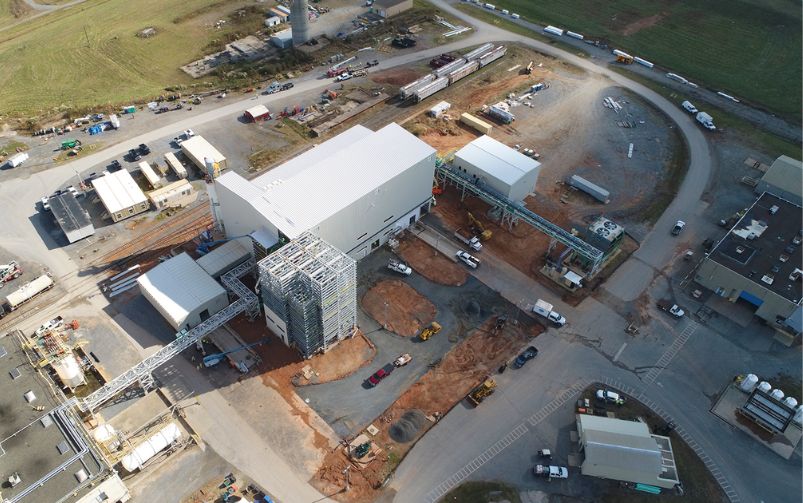Argonaut Gold poured its first gold at the Magino mine on June 14. Courtesy of Argonaut Gold Inc.
Welcome back to your weekly mining news recap, where we catch you up on some of the news you may have missed. This week’s headlines include Glencore making another bid for Teck, Canadian and American mining companies considering business in the Kazakhstan mining sector and the planned restart of the idle St. Lawrence fluorspar mine in Newfoundland.
Manitoba’s first potash mine has officially opened in Harrowby, as reported by the CBC. The mine, operated by the Potash and Agri Development Corporation of Manitoba (PADCOM), is expected to produce 250,000 tonnes of potash per year once it ramps up to full production. Manitoba premier Heather Stefanson said the mine will be a low carbon facility due to being a solution mine powered by Manitoba’s hydroelectricity. Gambler First Nation is a 20 per cent equity partner in the project and 11 per cent of the mine’s net profit will be given to local First Nation communities and the Manitoba Métis Federation.
All of the companies with mine operations interrupted by wildfires in Quebec noted in last week’s recap–Hecla, Agnico Eagle, Wesdome, Champion Iron, Iron Ore Company of Canada–have since resumed operations. Rains have helped control the fires, but as of Thursday there were still 120 active fires burning in the province, as reported by CTV News.
Rio Tinto is expanding its low-carbon AP60 aluminum smelting technology at its Complexe Jonquière in the Saguenay–Lac-Saint-Jean region of Quebec. The $1.4 billion investment from Rio Tinto is the most significant in the aluminum business in the western world for more than a decade, according to CEO Jakob Stausholm, and the addition of a further 96 AP60 pots will increase the smelter’s annual production from 60,000 tonnes of primary aluminum to 220,000 tonnes. The provincial government is contributing up to $150 million towards the expansion.
Argonaut Gold poured the first gold at its Magino open-pit mine near Dubreuilville, Ontario, on Wednesday, as reported by Northern Ontario Business. The Magino mine, which was profiled in CIM Magazine’s March/April 2023 issue, is anticipated to produce between 72,000 to 81,000 ounces of gold this year at cash costs of between $850 and $950 per ounce. Full production is expected in the third quarter of this year.
Several Canadian companies visited Kazakhstan’s capital, Astana, to discuss a potential launch of a U.S.-Canada regional hub, as reported by The Astana Times. A special session was held as part of the 13th Astana Mining and Metallurgy Congress to consider opportunities for American and Canadian companies, including Hatch, Cameco Corporation, Barrick Gold, Arras Minerals, Nutrien, Teck Resources and B2Gold, that are doing or considering business in the Kazakstan mining sector. Canadian businesspeople said Kazakhstan has untapped resource potential, which Canadian companies can help develop with their experience and technology.
Glencore is among the companies that has offered to buy Teck’s steelmaking coal business, confirmed the Canadian miner, as reported by the Financial Post. This comes after Teck announced last week it was engaging with multiple companies that offered to buy its coal business. Glencore made two separate bids for Teck in April, but both offers were rejected. Teck stated that the latest Glencore proposal is “preliminary in detail, conditional and non-binding.” Teck also continues to engage with other parties and reiterated there is no assurance of a result with any of the transactions.
The idle fluorspar mine in St. Lawrence, Newfoundland and Labrador, could resume production by November, as reported by the CBC. The mine’s previous owner, Canada Fluorspar Inc., was forced to close the mine in February 2022 when it ran out of cash. Fluorspar Holdings PTE Ltd., a subsidiary of the private equity firm AMED Funds, purchased the mine for $25 million and the sale was approved last week. AMED Funds also owns a fluorspar mine in South Africa and has more than $1.4 billion in assets under management.
The CEO of Chilean state-owned major miner Codelco has stepped down following a year in the position due to personal reasons and “complexities” in running the company, as reported by Reuters.Andre Sougarret, an engineer, became a public figure when he led the rescue of the 33 miners trapped underground for 69 days at the San José mine in 2010. Recently Codelco was tasked with making agreements with lithium companies following the nationalization of the lithium sector. The government has also increased taxes and royalties owed by large mine operators.
Hecla Mining developed the Underhand Closed Bench (UCB) method, a narrow-vein underhand longhole mining method, to help its Lucky Friday mine control mining-induced seismicity, wrote Alexandra Lopez-Pacheco in the May issue of CIM Magazine. The Lucky Friday underground silver, lead and zinc mine, which is located in Idaho, U.S., had been testing various methods to palliate its seismic activity for 40 years, but now, the successful use of UCB has improved worker safety and increased the mine’s production.
Anglo American and Jianxi Copper Company, one of China’s largest copper producers, have agreed to collaborate to provide greater assurance on the way copper is mined, processed and brought to market, as reported by International Mining. The memorandum of understanding, which was signed in China, aims to create sustainable value chains beyond Anglo American’s mining operations, as well as supporting the long-term decarbonization goals of Jiangxi Copper and the Chinese mining industry. China is the world’s largest copper-consuming nation, accounting for more than half of the global demand for refined copper.
A number of research projects with promising benefits for the mining industry are under way in Ontario, as the province cements its place as a hub for innovation, wrote Kelsey Rolfe in the May issue of CIM Magazine. The Mining Innovation, Rehabilitation and Applied Research Corporation (MIRARCO) in Sudbury is currently building the Centre for Mine Waste Biotechnology, where it will test bioleaching and bioremediation processes, including a project with BacTech Environmental Corp. At the University of Toronto, researchers are working on nickel processing methods that could work for challenging deposits such as ultramafic low-grade nickel ores. Sudbury-based Symboticware is also working with Swarm, a SpaceX subsidiary, to create an asset performance management platform accessible from anywhere in the world, even without reliable internet or cell service, while the Centre for Smart Mining at Cambrian College in Sudbury is building a BEV lab that is scheduled to open this fall.
That’s all for this week. If you’ve got feedback, you can always reach us at editor@cim.org. If you’ve got something to add, why not join the conversation on our Facebook, Twitter, LinkedIn, or Instagram pages?




